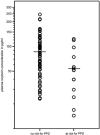Plasma oxytocin concentration during pregnancy is associated with development of postpartum depression
- PMID: 21562482
- PMCID: PMC3154107
- DOI: 10.1038/npp.2011.74
Plasma oxytocin concentration during pregnancy is associated with development of postpartum depression
Abstract
Postpartum depression (PPD) affects up to 19% of all women after parturition. The non-apeptide oxytocin (OXT) is involved in adjustment to pregnancy, maternal behavior, and bonding. Our aim was to examine the possible association between plasma OXT during pregnancy and the development of PPD symptoms. A total of 74 healthy, pregnant women were included in this prospective study. During the third trimester of pregnancy and within 2 weeks after parturition, PPD symptoms were assessed using the Edinburgh Postnatal Depression Scale (EPDS). Blood samples for plasma OXT assessment were collected in the third trimester. Following the literature, participants with postpartum EPDS scores of 10 or more were regarded as being at risk for PPD development (rPPD group). In a logistic regression analysis, plasma OXT was included as a potential predictor for being at risk for PPD. Results were controlled for prepartal EPDS score, sociodemographic and birth-outcome variables. Plasma OXT concentration in mid-pregnancy significantly predicted PPD symptoms at 2 weeks postpartum. Compared with the no-risk-for-PPD group, the rPPD group was characterized by lower plasma OXT concentrations. To our knowledge, this is the first study to show an association between prepartal plasma OXT concentration and postpartal symptoms of PPD in humans. Assuming a causal relationship, enhancing OXT release during pregnancy could serve as a potential target in prepartum PPD prevention, and help to minimize adverse effects of PPD on the mother-child relationship.
Figures
References
-
- Beck CT. The effects of postpartum depression on maternal-infant interaction: A meta-analysis. Nurs Res. 1995;44:298–304. - PubMed
-
- Beck CT. Postpartum depression. Am J Nurs. 2006;106:40–50. - PubMed
-
- Bergant AM, Nguyen T, Heim K, Ulmer H, Dapunt O. German version and validation of the Edinburgh postnatal depression scale (EPDS)) Deutsche Medizinische Wochenschrift. 1998;123:35–40. - PubMed
-
- Bloch M, Daly RC, Rubinow DR. Endocrine factors in the etiology of postpartum depression. Compr Psychiatry. 2003;44:234–246. - PubMed
-
- Brummelte S, Galea LAM. Depression during pregnancy and postpartum: Contribution of stress and ovarian hormones. Prog Neuro-Psychopharmacol Biol Psychiatry. 2010;34:766–776. - PubMed
Publication types
MeSH terms
Substances
LinkOut - more resources
Full Text Sources
Other Literature Sources
Medical



